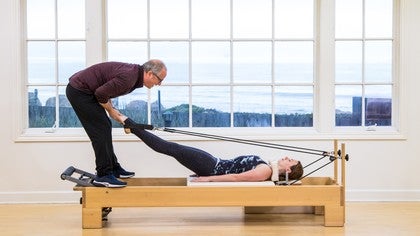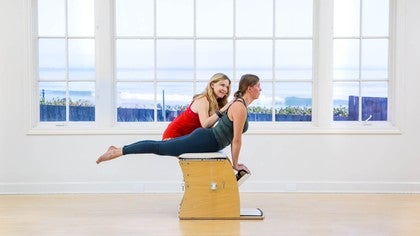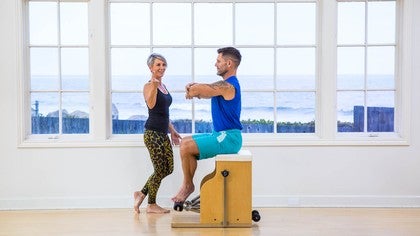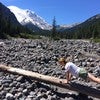Description
About This Video
Transcript
Read Full Transcript
Hi, I'm Trish McCarty. Thanks for clicking on watching me. Today we're going to talk about, uh, working with the legs in arms and ballet, and I've got this great student here named Shelby. She studies from Amy Haven, so I'm very, very excited to work with you. So shall be, if you'll go ahead and lay down and we're going to start with some foot work. So we're gonna start with your heels on the bar and you're going to be in a v. All right, so not a lot of turnout. Your dancers are gonna want to go into extreme turnout for you.
W what you want to do is you want to kind of pull them back and make them work within a range. It's a little bit more comfortable. They're always standing in this extreme range, so kind of pull them back, put them in a range that's not so much turnout. So we have a little gentle squeeze of the hill. So let's begin with some footwork. We inhale, we exhale weak stent out one, and then we pull it back in and we press two and back in and we reach out three. Good. And back in, we reach out four.
Let's do one more and back in and press Pi. Very good. And back in. All right, so we're kind of like emulating a plea. Now Shelby, what I'd like you to do is really think about recoiling this spring. You know, I studied from Bruce King and Bruce was all about extending the spring and bringing the spring back in. So let's try five more that way. So let's prepare with the in help please. And during your exhale, let's go ahead in this progress, the carriageway one. Now pull this screen spring back in and press to good and keep some energy in those springs. Good. And go three. Excellent. And back in go four.
Let's do one more good and press five. Excellent. And pull it back in. Great. Now let's go down to your toes. Now we want to see the heels dropped down towards a gear bar. So it stays isolated into your hip. Sorry. Right? So again, we want to see a little gentle squeeze of the heels together to get the inside of the leg to activate a little bit. We're watching the placement of the foot. We have 6% between the big toe and second toe, 40% out through the rest of the toes, so they get that great structure through the ankle.
Let's prepare our body with the inhale and as Xcel Nix, extend the Carytown press and we pull this, bring back to it's recall. Very good, and we're squeezing the hills too. Good. And back in, press the three and back in we press four and pressed by good work and Eh, and you reach your ears out six and back in press seven and in press eight let's do two more please. And press nine one more. Good, and press 10 very good. And bring it in. Now we're going to elevate those heels up, right? Keep that same amount of turnout and make sure I see that toe bone drop down.
All right, let's take her inhale and let's exhale and let's push the carriage way and stretch one. Excellent. And pull the carriage back in and press to good and back in press three and in press four. Good. Pull it in. Press five and [inaudible]. Press six. Polar it in, press seven and in press eight let's do two more. Please press nine now on the 10th one.
Hold it out there and press out. Now reach and let's do some heel drops. Connect these heels and we lower the heels down. Softly one. This is two five and back up. Excellent. Go to instill a little gentle squeeze and I stretch your legs. There you go. And go three perfect. And back in.
Go for excellent and back in one more please. Impressed by good and pull it back in. Perfect. Thank you. Now let's go to a parallel position, right? So we're going to be right across from the sit bones and I want you to drop your heels down and wrap those toes around. That wrap position is so important because it really, really hits all those intrinsic muscles of the foot.
All those muscles are activating, so healthy for your dancers. We take a inhale, please. We accept, we push the carriage out and stretch one. We pull that spring back in. We pressed two and pull it in. Press three. Excellent. And pull it in.
Press four and pull it in. Press five. Let's do five more in back in. Perfect. Good movements. Six. And in press seven and in press eight two more, please press nine and one more. And press 10. All right, very good. And bring it back in. Now let's go to a second position. All right, so we're gonna put our heels out here.
So we're going to kind of open the turnout just a little bit more. I'm not letting my dancers fall out into the joint. I'm always bring pulling them back so they're working really healthy through that joint. Okay, so we're in a wide second position right now. Let's take an inhale please, and let's exhale and let's push the carriage way. Good.
Now pull the spring back in and press to excellent. And back in press three. Good. And back in press for good. And N, press five andN , press six. Good work. And N press seven. Good. N N press eight. Let's do two more, please press nine and one more.
Good work intern. Alrighty. Very good. And bring it in. Now let's go back to parallel. We're going to have the heels right and I want the heels right across from your two sit bones. All right. Now as you push the carriage out, we're going to go into a rotation. As you bring the carriage back in, we're going to go back to parallel, right? So your, your feet are going to be making this type of woman. So let's prepare our body with an help please. And let's exhale and let's go ahead and push out and rotate. Good.
And bring it back in and go back to parallel. Nice and go rotation. Good. And back to parallel at rotation. Sometimes I help by helping them find that nice turnout and bring it back in and press and rotate. Good. And pull it back and let's do one more please. And press and rotate.
Very good. And bring it back. It feels good, doesn't it? Right? Good. Okay, so that's the foot book that I like to teach. I'm always watching how my dancers open up the spring and close the spring structure of the foot. Nice movement quality. We're going to go into a single leg double paced series. Alright, so for this, uh, movement, we're gonna use two red springs, right? And we're going to put your right foot on the Bart, the base of your toe. Again, this heel needs to be down by the gear bar. This leg extends out over the bar. You're right. You know, sometimes we want to watch how far they drop the foot down the leg down because the weight of the quad can adjust the pelvis.
We want that publicity be in it's neutral. Also, what I'm looking for is the nice separation between the toe and the thigh. The answers want those long legs. They want you to see them. Legs are so important in ballet because they communicate, they emit feelings and emotions. So what we're going to do is we're going to press the carriage way and you're going to bring it into a devil. Pay All the way up to the ceiling. Good. Now listen, this, pull that pelvis down right there.
Now we're going to hold the carriage out there and we're going to lower the put down to a grump op ball. So keep your carry chart there. So curious to see that we do a grump bump mall and back up. Now we're going to flex this foot and do a heel drop here. We're going to point this foot and lift that heel. We're going to bend this knee and we're going to reach it out and stretch, right? So let's try that one more time. So we go, Deb, pay wrong.
But Ma we flex, we point, we bend one more time. The love pay grown. But Ma now we flex and point and Ben and reach. All right, good. So we got the movement right. So this is a lot of movement and we're looking for the publicists stay absolutely stable. Also dancers really like the coordinate movement.
So what I want to see you do is as you take your debit pay, I want both needs to stretch at the same time. So we go Dev, love, pay grown, but mark and we flex in, we point and we bend. One more time. We'd go, Deb [inaudible] reach that leg. We flexin we point and we been very good. Let's try the other leg. All right, so we're here getting, we're looking at the placement of that foot, the heels down just a little bit. We have nice long leg. We're looking at separation of Tov and thigh.
We go Deb the pain and they ground my and we flexing, we point and we bend in, we reach in, we dabbed, the pay. Grom bought Ma and they flux in a point and they bend in the region. They Dev the pay and they ground bought more flex in a point. One more time, man. They reached in Dade, a [inaudible] ground, flex and point and they've been very good. Excellent, excellent. Very nice. So a lot of movement. Now what you're looking for again, is for that pelvis remain like a punchbowl and have the dancer uses the legs.
Remember those legs have got to communicate. They've got to be expressive. Articulate. All right, so let's move on. So let's sit up on the carriage and we're going to do hug a tree, right? So the other Perth that our dancers use are the arms, arms are extensions of back and bower. So I to tell my dancers, feel like your these arms are extending way from the back.
They're filling this whole room up with a movement. So go ahead and sit there. It'll, we'll grab the straps for you. Now you can sit with your legs, criss cross or you leg straight out. Let's bring this bar down so we get a good clean view of the machine here, right? So you can sit with your legs crushed, crushed. You're fine with that. All right, great. So we're going to grab the straps right there, here, right here. So hug a tree, right? So the arms are out. Right now what I'm looking for is for the shoulder to be down the elbow a little bit lower than the shoulder and the grist is a little bit lower than the elbow.
It was like if I was put some water, it would run right off I muscle looking for this arm to be extension from this back. All right, so let's try this one. So let's take an inhale and let's exhale and let's go in. You go one and then press it up. Good and go to good. And press those. Just the arms moving. The body stays absolutely stable.
Three good. And O and n. Good and out. Very good. Now what I want you to feel pulling in as beautiful. You're doing it really well. You want to be two fingers apart right now when you press back out and want to feel like you're pushing something away.
So we go in one and PR. Yes, very nice. Go to good. And we press. So again, we're opening that spring. We're closing that spring. Let's do one more. Good and in very good press. All right, go ahead and relax a moment there. I'm going to come to the back of you. And what I want you to do is I want you like to tell a story with your back.
I want your back to be so expressive. All right, so here I go. To the back of you, your arms, come back up to your hug a tree. So I'm looking at this beautiful back right now. Those arms are extending from the back. Here we go. Let's start with the movement. We go in one. Excellent.
And we press out there. The back is communicating. Go to nice and back out. Let's do one more and go three. Very good and back out. Excellent. Let's go ahead and relax moment. All right, let's go ahead and extend the leg straight out now. All right, you're sitting nice and tall on those sip bumps, right?
And we're going to start with the arms here and we're just going to do a basic rowing. All right? So we're going to press the arms out. So we go press out one and the arms go down to the thighs, to the arms, come all the way up to the ceiling three. And we go round and back in on four. All right, so there's a lot of movement happening here and what I'm looking for Shelby to do is the whole that spine straight up while the arms expressive, feeling express a movement. Okay, so what was you to feel like you're doing this? You're going to fill this whole room up with these arms coming from your back, right? Here we go. Inhale. And it's go press, send a down. Good. And, and around.
Let's do two more press and a and up a round. One more. And Press and uh, and up. Very good. And around. Alright, so let's just add a little bit more to this pressing. I was beautiful. All right. I want you to feel like you push the floor away. You lift the spine higher. Now we're pushing this ceiling back up. We're pushing the walls out and we're bringing it back in. So I see that, you know, quality of movement. All right, here we go.
So we go press away one and down and push those ceiling back up. Excellent. And arms back out. And we go to good and down. Good and arms. One more time please. And we press and down and arms all around.
Very good. Very great. Thank you. Go ahead and lay back down and we're going to go into some legs. All right, so I'm gonna use two red springs for this. You're okay with that, right? And let's go ahead and get us. Get these legs into the strips here. Alright and here we go. So where are your dancer puts a straps on?
It's always down by the mouth of the heel. That's important cause sometimes the strap can change the angle of the ankle. All right, so we want see that good structure and we're going to start with the leg straight up to the ceiling. We're going to be in a parallel position. We have the tailbone down. Again, we're looking for the separation of the toe and the thigh so the legs are long. Let's prepare our body with an inhale using the backs of your legs.
Let's exhale on this Paul, the straps down one very good and this bring it back up. Good. So the backs of your legs, Paul, the spring apart. Now the friends of those legs are going to bring that spring back in. Let's do one more and back. Good and back up. All right, now lets this be a little bit more expressive.
I'm going to get up here with you on this. All right. Now I want you to feel like you're really, really lengthening these legs. So go ahead and pull down and feel this length happening. I so feel like you're too long. Now we go long back up and reach and try to push me off the carriage.
Good. And back up. Let's do one more and reach good and back up. Let's open her legs to the width of her hips. This do the same thing. Now it's not about the foot in the strap, it's about using the back of your leg. This strap is this to help the leg, you know, find it's placement. All right. So I really want my dancers to concentrate on using the back, the low glute as they would like. Anton dues, Jack Tase.
And you know this simple movements they do every day in the ballet class. So listen, help please. And then this exhale. Let's go ahead. Pull down softly. One accident reached those legs, long pole up through that waist and bring it back up. And we go to good. And back up we go. Three. Good.
And back up. Let's do one more and we go for good and back up. Let's go into a first position. Right now we kind of little squeeze of the hills together and we're going to do this same thing. So we took the inhale, we axle, we reached the legs all the way to the wall. It goes back up to the wall, to the corner of the warrant. Meets the ceiling.
Now the ceiling. So we're making the longest path we can with our legs too. Excellent. And back up. Go three. Good and back. Let's do one more good. And we'd go for perfect. Very good.
And back up. All right. And let's go internal. All right. You're probably gonna get a fight from your ballet dancers on this, but if you really convinced them that the internal position will help strengthen the external position, you'll pray when that battle with them. Take your inhale. Exhale, go ahead and down you go. One, pull that navel in and bring it back up. And two. Good. Excellent. And back up. Go. Three. Good.
Back Up. We go for good. And back up. Let's do one more please. And we go fi very good and bring it back up. All right, very good. So there's many more things we can do with the legs and straps, but the main thing that I really teach my ballet dancers is that they want to separate that toe from the thigh. All right? Pelvis stable.
Nice placement of the torso. Nice organized torso. Let's move on. All right, so let's go ahead and Benner needs this. Come Outta here, police. Alright, and then we're going to go ahead and we're going to stand onto the floor and we're going to go to one red spring and we're going to do a standing platform. All right? Okay. So once you come around here and we'll face everybody. So we step onto the wood platform first and the moveable carriage second. All right, so we're going to be in parallel right now.
Now what I'm looking for with my dancers is for the knights lifted torso, the abdominals in the shoulder blades are way down here in the fingertips. All right? And I also want them to kind of push their hips for just a little bit. Keep that torso along. All right, now they're on top of their leg. I want to see that leg fully functional as the foundation.
Let's go ahead. Let's send the carriage out, please press one and we keep the tailbone down to gravity and we pull it back up and we go to good. Nice. Lift up through the tops of the ears. Good. We go three. Excellent. And back up. Let's do one more and we go four and close that spring back up. Perfect. Now lets go into a turned out position. Not a lot. Okay.
This is no need for that right now. All right, so the tailbone strapping down again. All right. Again, what we do is we want to take the hips, this push him for a little bit. I'm not asking the dancer to talk the pelvis, I'm asking the dance. Who the bring the hip bones forward. So we are on top of those legs. They're fully functional. I see the low gluten gauge, the hamstring engage, good placement of the feet. Let's take our in help please.
Let's XL and let's press the carriage away. One good and then Paul, the carriage back again. And we go pressed too. Good. And pull it back in. Press three. Good. And pull it back in. Press for good, and pull it back. And let's do one more please.
And press five. Very good. Yeah. And pull it back in. All right. Go ahead and step off for me, please. Alright, so that's good for legs. I hope you enjoyed it. Remember, arms and legs and ballet are so important for dancers. They communicate feelings, they express emotions. Very, very articulate. Have Fun. [inaudible].
The Teacher's Corner: Hands-On Adjustments
Comments
You need to be a subscriber to post a comment.
Please Log In or Create an Account to start your free trial.
















